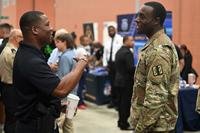The following originally appeared on LinkedIn.
What makes transition hard for people used to doing hard things?
I've spent countless hours trying to answer that question and fully understand the human experience of military to civilian transition, and I think I'm getting close. My level of understanding is unique, gained through interviews, work experience, observations as a military spouse, thesis research and education in psychology and organization development.
Because of that, I understand both military and civilian organizational cultures and how each operates. This point of view allows me to see and appreciate the gargantuan gaps that veterans must navigate in moving from one to the other.
Related: Search for Veteran Jobs
While the experience of the military to civilian transition is unique for each individual and cannot be simplified or time bound, I know that a majority of veterans feel a tremendous sense of loss in a variety of ways. Their loss may be related to their self-identity, self-worth, purpose, community, camaraderie, confidence, competence, professional network, prestige, family-like stability, financial security, career map, daily routine and their "right and left lateral limits."
Recent veterans gain a new level of personal freedom the day they pick up their DD214, the form that officially ends their service contract. But that newfound freedom is a dramatic change and can also make transition "hard." Unlimited choices can be paralyzing for some while others may struggle with acting independently and on their own behalf for the first time since leaving home headed for boot camp. What I call "warrior pride" may also cause internal conflict, because "warriors" are trained to make decisions, forgo help and leave no one behind.
The transition is undeniably hard. And in my quest for understanding and to make it less hard I discovered David Rock's SCARF model.
The SCARF framework is based on Rock's neuroscience research. It addresses the five domains of human social experience: status, certainty, autonomy, relatedness and fairness (SCARF). His data found that the brain treats many of these social threats with the same intensity as physical threats. (Consider for a moment that a threat to "status" triggers the same response in the brain as a threat to life. Read that again.)
These five threats impact the ability to make decisions, solve problems and collaborate.
And because the military to civilian career and cultural transitions require all three abilities and more, I believe being aware of the threats and taking action to reduce them will make the transition less hard and improve outcomes for everyone.
How can a transitioning veteran address them? Here are the five threats of the SCARF model, a few threat-reducing suggestions for pre-transition troops and recently transitioned veterans.
Threats to Status
In the military world, status isn't a conceptual hierarchy or little reviewed organizational chart. Instead, it is the rank structure and chain of command by which everyone who puts on the uniform lives.
The hard truth is that veterans must accept the loss of their military status once in the civilian workplace. Their new status should come from the individual talents and skills that earned them their military status and that can be applied in their current organization.
Veterans should also look for ways to reinforce their status in other roles outside of work while integrating and building credibility in the civilian workforce. This inevitable threat to status can be reduced by spending time with those people who view the veteran as important. For example, status may be reinforced while acting as a parent, coach, mentor, teacher or leader.
They should act like a proud and humble veteran, one who recognizes that even though work experience is cumulative, not all of it is transferable. Those military leadership skills may not inspire followership automatically on a new battlefield. Establishing status as a veteran employee requires intention, humility, patience and resilience.
Threats to Certainty
Veterans can be certain of uncertainty in their military to civilian transition -- as well as personal transformation.
The uncertainty is predictable because non-veteran civilians have differing levels of accountability and value systems. Organizational structures are flatter, and the chain of command may be unclear. Organizations each have their own unwritten rules and norms that will, oftentimes, be discovered the hard way.
Veterans can reduce the threat to certainty by setting their own realistic expectations and timelines. They should set daily goals for small wins and reward themselves often.
Threats to Autonomy
Also referred to as "personal agency" or "free will," for veterans, this threat requires a mindset shift from "team" to "me" and the awareness that survival now depends on independent decision-making, self-promotion and self-determination. In truth, this may be the hardest part of the transition experience for service members who have rarely, if ever, exercised their personal agency.
For veterans, the threat is not in losing autonomy; it's in the challenge of reclaiming it.
Unlimited choices can be paralyzing for some veterans. Additionally, there may be barriers to agency and autonomy, such as feelings of disloyalty and being uncomfortable when recognized or singled out.
Veterans can reduce the threat of unlimited autonomy by being aware and intentional about transforming their mindset. They should take the liberty to redefine their "purpose" and identify where they can contribute to someone or something bigger than themselves. They should focus on empowering themselves to take action, make decisions and take risks.
They should also identify civilian role models, mentors and sponsors and start small with words such as "I prefer ...," "I believe ...," and "In my opinion ..." Finally, veterans should give themselves a break. Their level of selflessness is what saved lives and has become hard-wired. Shifting their mindsets will not be easy or happen overnight.
Threats to Relatedness
The threat is real when it comes to losing community, relationships, camaraderie, self-identity and more. The only way to reduce this threat is to find a new community and attach to it. Veterans should join a club, become a coach, secure employment, volunteer for a cause, join a gym (off-base) or enroll in higher education, certification programs or trade schools. It's important that they find a place where they are expected and where they feel a sense of belonging.
Veterans should find their (civilian) people, show up and participate regularly. They should build relationships by sharing stories while doing something together. Spouses are transitioning, too, and should be included in group activities and encouraged to find their own. This social connection has the potential to offset the tremendous loss experienced by many and make every other aspect of transition easier.
Find your (civilian) people. Show up. Get the T-shirt, and if you have a spouse, get two.
Threats to Fairness
Veterans must accept that civilian life may be perceived as "unfair" or "unjust."
Less qualified applicants will get the job, and co-workers will be promoted over them because of internal politics. Compensation levels will vary within the same roles, and salary information is private. They should also remember that civilians behave according to their individual values, which may conflict with the values instilled during military service.
Veterans should also know that fairness to civilian employees means they all have a voice and expect to use it so veterans in leadership roles should ask a lot of questions. The best approach is to reduce the threat of fairness by expecting unfairness (according to military cultural standards) and acting fairly (according to civilian cultural standards).
For More Information
For more on the SCARF Model, watch this video. More insights on change and transition are included in this article, "How to Transition Through Change," from the Center for Creative Leadership. Finally, William Bridges' book, "Transitions," is a must-read for anyone in any kind of transition or anyone serving them.
A Special Note for Providers, Educators and Employers
With these threats in mind, think about how you can adapt your policies, communications and interactions with veterans to create a less threatening and more welcoming environment.
How can your actions impact the experiences of these vets and help them navigate and reduce the SCARF threats?
Sara McNamara is a tireless advocate for veterans and all newcomers. She's a scholar in the 2019 George Bush Presidential Stand-To Veteran Leadership Program, working to lead change and improve veteran outcomes nationwide. A military spouse and recent graduate of the Pepperdine University global MSOD program, she works with HireMilitary.us and MVPVets.org, because she believes employment is the best transition assistance and mental health care for veterans.
Find the Right Veteran Job
Whether you want to polish your resume, find veteran job fairs in your area or connect with employers looking to hire veterans, Military.com can help. Sign up for a free Military.com membership to have job postings, guides and advice, and more delivered directly to your inbox.











